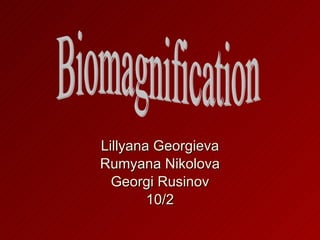Biomagnification 10-2
•Download as PPT, PDF•
14 likes•8,120 views
Report
Share
Report
Share

Recommended
Ecology 407 2018 lecture 2 biological magnification

Ecology 407 2018 lecture 2 biological magnificationStella Maris Polytechnic; Mother Patern College of Health Sciences
Recommended
Ecology 407 2018 lecture 2 biological magnification

Ecology 407 2018 lecture 2 biological magnificationStella Maris Polytechnic; Mother Patern College of Health Sciences
More Related Content
What's hot
What's hot (20)
Biomonitoring: Its Expanding Role in Public Health Evaluations and Litigation

Biomonitoring: Its Expanding Role in Public Health Evaluations and Litigation
BIOINVASION INVASIVE SPECIES, NATIVE SPECIES, EXOTIC SPECIES

BIOINVASION INVASIVE SPECIES, NATIVE SPECIES, EXOTIC SPECIES
Similar to Biomagnification 10-2
Similar to Biomagnification 10-2 (20)
Dangers of bioaccumulation of some heavy metals consumed in sardine and macke...

Dangers of bioaccumulation of some heavy metals consumed in sardine and macke...
STUDY ON MICROPLASTIC CHALLENGE – INDIAN STATUS AND SOLUTIONS 

STUDY ON MICROPLASTIC CHALLENGE – INDIAN STATUS AND SOLUTIONS
4.11 - "Aquatic biomass as a source of renewable energy" - Miroslaw Krzemiene...

4.11 - "Aquatic biomass as a source of renewable energy" - Miroslaw Krzemiene...
Ecotoxicants and Pathologies Occurring in Productive Animals Body under their...

Ecotoxicants and Pathologies Occurring in Productive Animals Body under their...
More from MrJewett
More from MrJewett (20)
Jetcheva filipova kalpakov raynova 10 4 inv species

Jetcheva filipova kalpakov raynova 10 4 inv species
Recently uploaded
TỔNG ÔN TẬP THI VÀO LỚP 10 MÔN TIẾNG ANH NĂM HỌC 2023 - 2024 CÓ ĐÁP ÁN (NGỮ Â...

TỔNG ÔN TẬP THI VÀO LỚP 10 MÔN TIẾNG ANH NĂM HỌC 2023 - 2024 CÓ ĐÁP ÁN (NGỮ Â...Nguyen Thanh Tu Collection
Mehran University Newsletter Vol-X, Issue-I, 2024

Mehran University Newsletter Vol-X, Issue-I, 2024Mehran University of Engineering & Technology, Jamshoro
Recently uploaded (20)
TỔNG ÔN TẬP THI VÀO LỚP 10 MÔN TIẾNG ANH NĂM HỌC 2023 - 2024 CÓ ĐÁP ÁN (NGỮ Â...

TỔNG ÔN TẬP THI VÀO LỚP 10 MÔN TIẾNG ANH NĂM HỌC 2023 - 2024 CÓ ĐÁP ÁN (NGỮ Â...
Micro-Scholarship, What it is, How can it help me.pdf

Micro-Scholarship, What it is, How can it help me.pdf
Unit-V; Pricing (Pharma Marketing Management).pptx

Unit-V; Pricing (Pharma Marketing Management).pptx
Russian Escort Service in Delhi 11k Hotel Foreigner Russian Call Girls in Delhi

Russian Escort Service in Delhi 11k Hotel Foreigner Russian Call Girls in Delhi
Seal of Good Local Governance (SGLG) 2024Final.pptx

Seal of Good Local Governance (SGLG) 2024Final.pptx
Python Notes for mca i year students osmania university.docx

Python Notes for mca i year students osmania university.docx
Mixin Classes in Odoo 17 How to Extend Models Using Mixin Classes

Mixin Classes in Odoo 17 How to Extend Models Using Mixin Classes
ICT Role in 21st Century Education & its Challenges.pptx

ICT Role in 21st Century Education & its Challenges.pptx
General Principles of Intellectual Property: Concepts of Intellectual Proper...

General Principles of Intellectual Property: Concepts of Intellectual Proper...
On National Teacher Day, meet the 2024-25 Kenan Fellows

On National Teacher Day, meet the 2024-25 Kenan Fellows
Asian American Pacific Islander Month DDSD 2024.pptx

Asian American Pacific Islander Month DDSD 2024.pptx
This PowerPoint helps students to consider the concept of infinity.

This PowerPoint helps students to consider the concept of infinity.
Biomagnification 10-2
- 1. Lillyana Georgieva Rumyana Nikolova Georgi Rusinov 10/2 Biomagnification
- 4. How does biomagnification look like? http://web.bryant.edu/~dlm1/sc372/readings/toxicology/biomagnification.jpg